项目名称:喀拉卡尔藏族美食文化中心
项目类型:建筑改造
项目地点:中国云南省迪庆藏族自治州香格里拉市安康巷4号
设计单位:平介设计、云南福龙设计事务所有限公司
项目团队:扎西培楚,杨楠,王乙童,李宗键
建成状态:建成
设计时间:2018年10月-2020年1月
建设时间:2020年1月-2020年10月
建筑面积:1000平方米
摄影:扎西培楚
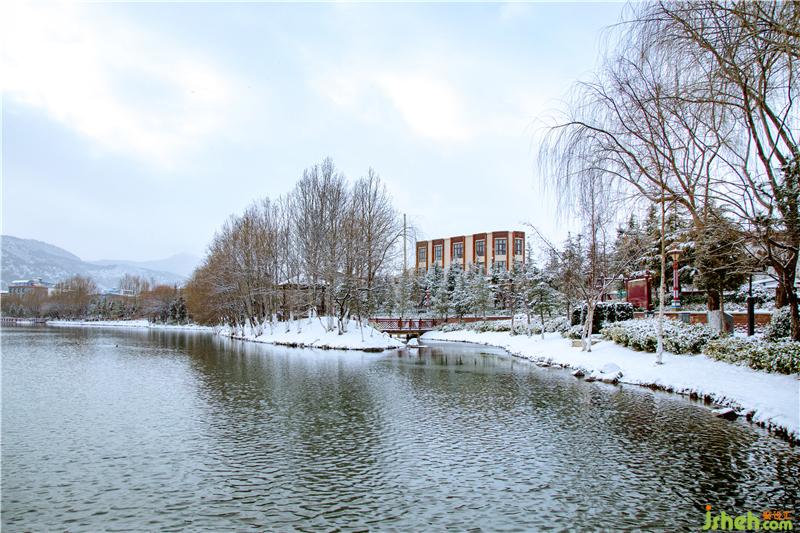
远看建筑©扎西培楚
在喜马拉雅山脉以东,有一系列南北走向的高山峻岭,这就是中外闻名的三江并流的横断山脉地区。香格里拉,地处三江并流腹地,作为历史上茶马古道的重镇,不同民族文化在此交汇融合,造就了当地独具特色的文化环境。从二十世纪初约瑟夫·洛克初次将横断山区展现于世界前,再到詹姆斯·希尔顿笔小说里的净土,香格里拉以其自然风光与民俗文化吸引着世界各地的旅客来此寻找心中的家园。
In the northwestern part of Yunnan Province, in the Hengduan Mountains, there is a mysterious and tranquil place called "Shangri-La". This place Located in the hinterland of the Three Parallel Rivers, it was once an important town on the Ancient Tea Horse Road. The integration of multiple ethnic groups has created a unique local cultural environment, attracting tourists from all over the world to find their homes in their hearts. At the beginning of the 20th century, the Hengduan Mountains were first shown to the world through the explorer Joseph Charles Francis Rock. In the 1930s, "Shangri-La" appeared in James Hilton's novel "Lost Horizon". The pure land depicted in the book was longed for by the world, and make Shangri-La known to the world.
项目定位与策划Programming
项目位置©平介设计
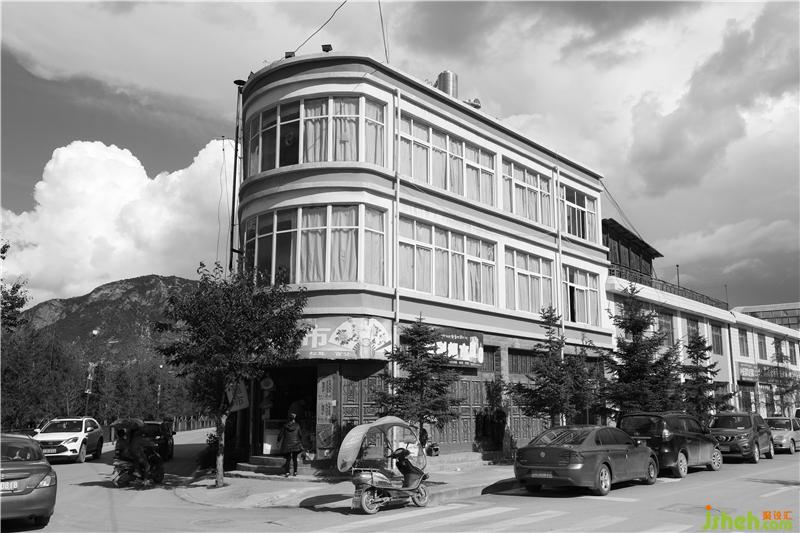
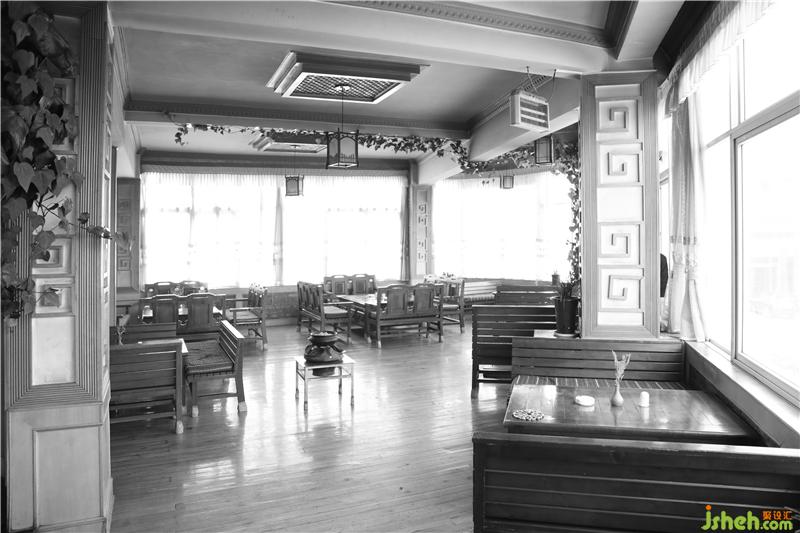
老喀拉卡尔藏餐厅照片©扎西培楚
二十年前,一户名叫白玛的家庭在香格里拉独克宗古城外城区开了第一家藏餐厅,这家名叫喀拉卡尔藏餐厅虔诚的追求“在’温暖’的香格里拉,开一家温暖的店,等候一群温暖的人来”的理念,生意追求不温不火为度,诚信真实食材为底。
Twenty years ago, a Tibetan family named Pema opened the first local Tibetan restaurant “Karakal" in the outer urban area of the ancient city of Dukezong, Shangri-La. Karakal pursues to protect the authenticity with care.Keeping the business moderate, and the food ingredients are natural. Always adhere to the concept of "open a warm store in the warm Shangri-La, and wait for a group of warm people to come".
二十年后的今天我们希望以白玛·喀拉卡尔的积淀为基础,展现香格里拉独特的地域文化,设计改造一个新的复合空间,一个能让旅客品尝到香格里拉原真的藏族美食的舒适餐厅。同时,我们设想这个空间也是香格里拉各界文化人士相聚与交流的家园。这里可为诸如文化沙龙,摄影展,座谈会等各类文化活动提供场所。通过舒适优雅的环境与丰富的文化活动将大家连接在一起,期待文化与思想的交流能够迸出精彩的火花。
Today, twenty years later, we are designing and transforming a new composite space, hoping to use the accumulation of Pema Karakar as the starting point and the most authentic Tibetan cuisine as the medium to show the regional cultural characteristics of Shangri-La. At the same time, we envision this space as a home for local people from all walks of life in Shangri-La to gather and communicate. It can provide venues for various cultural activities such as cultural salons, photography exhibitions, and symposiums. Serving the cultural life of the local people through a comfortable and elegant environment. We looking forward to the exchange of culture and ideas can burst out wonderful sparks.
建筑改造Architectural Transformation
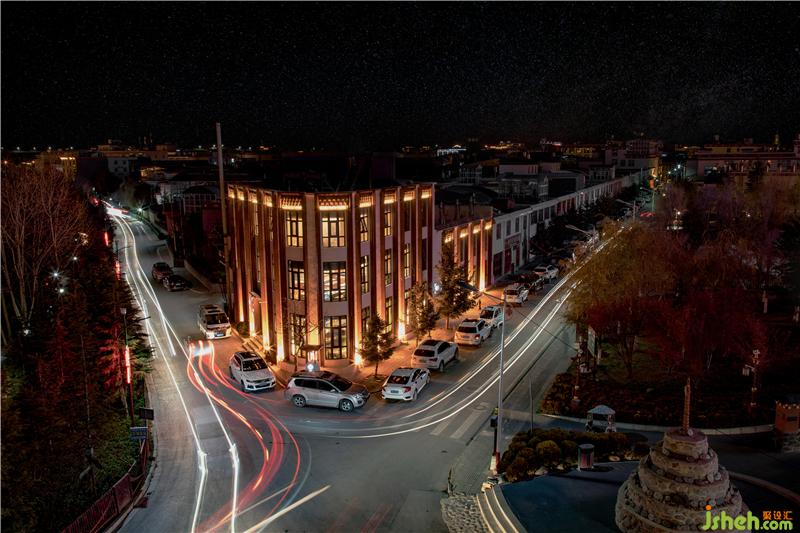
外立面夜景©扎西培楚
场地由两部分组成:三层餐厅及两层庭院式住宅。现有三层建筑为十年前建成,旁边的老宅为九十年代所建,老建筑为10年前业主自建的砖混建筑,存在立面造型与所在地文化环境不符,空间利用低并在冬季存在严重的保暖问题。
The site consists of two parts: a three-story restaurant and a two-story courtyard residence. The existing three-story building is a brick-concrete building built by the owner ten years ago, and the old residence next to it was built in the 1990s. The facade of the original building on the site does not match the local cultural environment, in the meantime the space utilization is low, and there are serious thermal problems in winter.
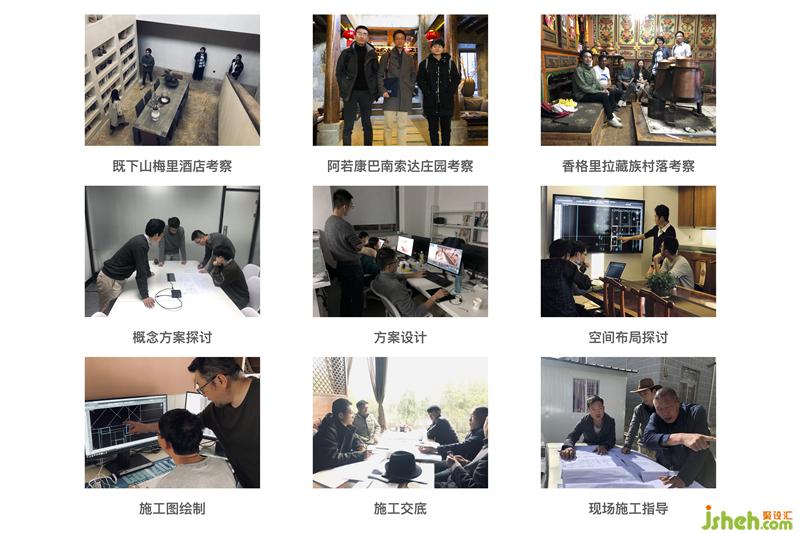
设计过程©平介设计
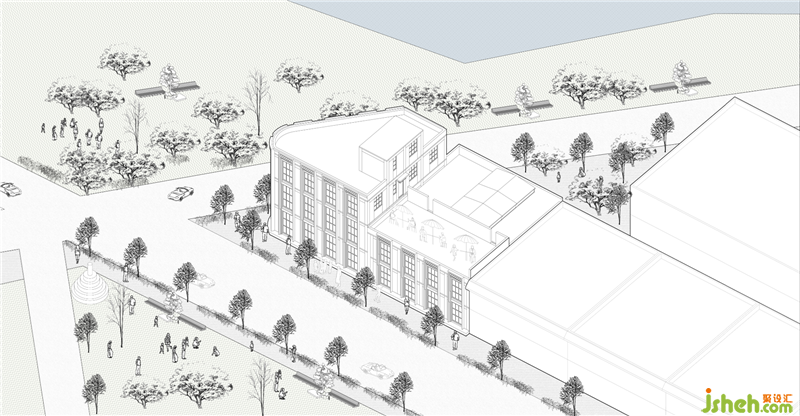
建筑轴测图©平介设计
在一个具有强烈地域性建筑文化的环境里如何以现代的手法,设计出一种既具现代感又蕴含藏地文化特色的空间形态与建筑是贯穿项目始终的目标与挑战。基于这个目标,设计团队也考察了香格里拉周边诸多传统建筑与新建的口碑项目(梅里既下山、阿若康巴酒店等)。受限当地政策(新城规划对立面风貌控制的要求)与项目预算,我们放弃了最初基于评估后认为结构不合理性提出的重建想法,转向通过对建筑外立面及室内空间进行改造的方式,以增加本土文化特征并提升室内环境品质。而在整个过程里我们尝试打破当地对于建筑盲目追求传统元素与材料堆砌而忽视使用体验的现状,回归并关注地域建筑的朴素、内敛与温暖,以及对使用体验的尊重。
In a context with a strong regional architectural culture, how to use modern techniques to design a built environment that is both modern and contains Tibetan culture is the goal and challenge throughout the project. Based on this goal, the design team investigated a number of traditional buildings around Shangri-La and several newly built commercialprojects with favorable comment (MSunyata Hotel in Meili Snow Mountainn, Arro Khampa Hotel, etc.). Initially, we proposed an idea of reconstruction based on the assessment that the original building structure was irrational. However, due to local policies (requirements for the control of facades in new town planning) and project budgets, we gave up the idea of reconstruction and switched to adopting the renovation of external facade and indoor space. The renovation increase the local cultural characteristics and improve the quality of the built environment. At the same time, we also tried to break the current situation of blindly pursuing traditional elements and materials in the building and neglecting the use experience during the whole design process, and returning to the basic consideration of the use experience, focusing on the simplicity, restraint and temperature of the regional architecture.
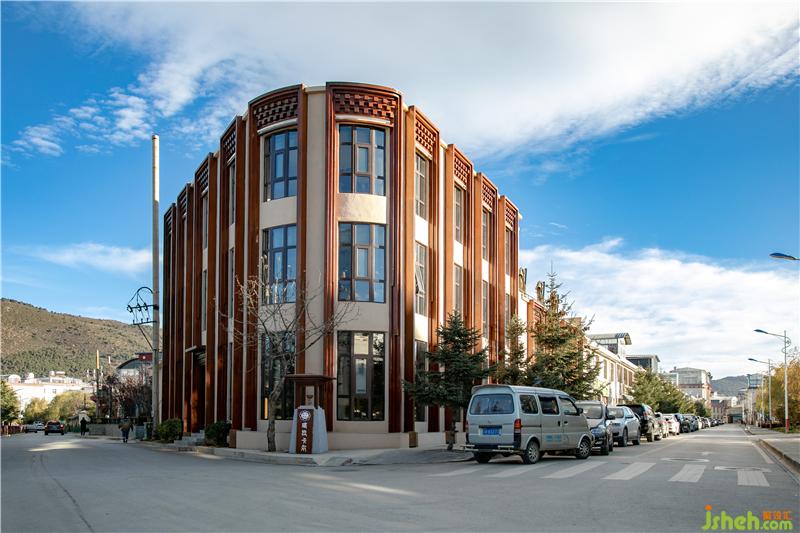
建筑街景©扎西培楚
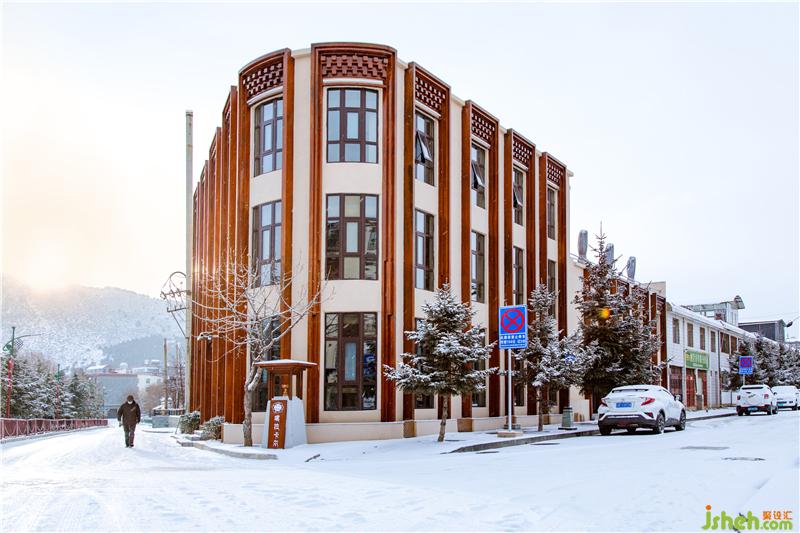
建筑街景雪景©扎西培楚
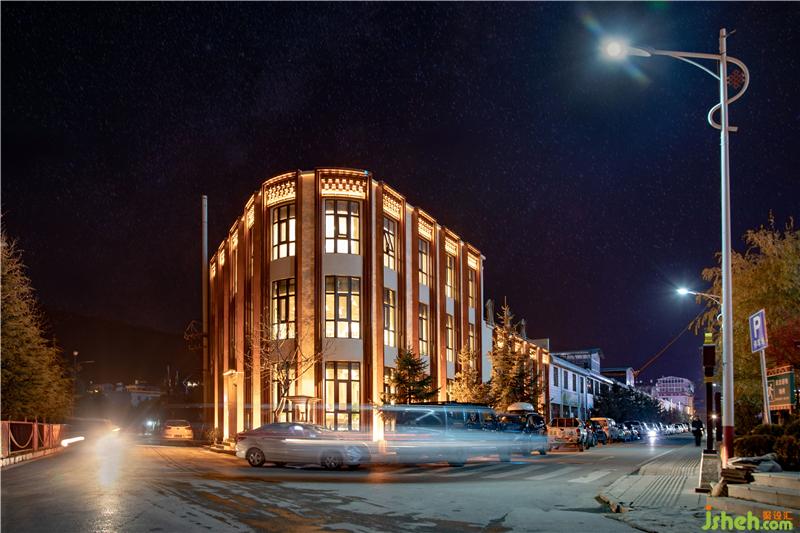
建筑街景夜景©扎西培楚
建筑外立面改造运用了藏族传统建筑的门窗元素,包括藏式九宫格窗(藏语 称 格尼)与飞子木窗头(藏语 称 八苏),并使用退台形式的窗套营造传统藏式建筑门窗所具有的层次与韵律,餐厅设计所有窗户均采用双层中空玻璃和加厚型材以保证室内保温效果。在窗头与窗套的材料选择上,我们使用了锈蚀折形钢板代替传统的木材,以解决木材在高原室外环境下不耐久的问题。外墙涂料使用了淡夯土黄真石漆来制造传统藏房的夯土墙的粗糙纹理质感,通过对传统元素的现代演绎,采用在地成本可控的现代用料以回应当地居民对地域建筑的“记忆”。在立面照明设计上我们同样避免使用直射光源而采用底部和凹槽打灯去突显材料和立面的质感。
The renovation of the external façade of building uses the door and window elements of traditional Tibetan architecture, including Tibetan-style lattice windows and wooden window heads, and use of window trim in the form of setbacks in order to create the rhythm of traditional Tibetan building doors and windows. In consideration of the plateau climate, all windows use double-layer hollow glass and thicker glass frames to ensure indoor thermal insulation. In the material selection of window head and window trim, we used rusty steel plate instead of wood to solve the problem that wood is not durable in the outdoor environment of plateau. The exterior wall was painted by pale rammed earth yellow real stone paint to create the rough texture of the rammed earth walls of traditional houses. Through the modern interpretation of traditional elements and use of modern materials with controllable costs we were able to respond to the "memory" of local residents to regional buildings. In the design of facade lighting, we also avoid using direct light sources and use bottom and groove lighting to highlight the texture of materials and the form of external facades.
室内改造与设计Interior Renovation
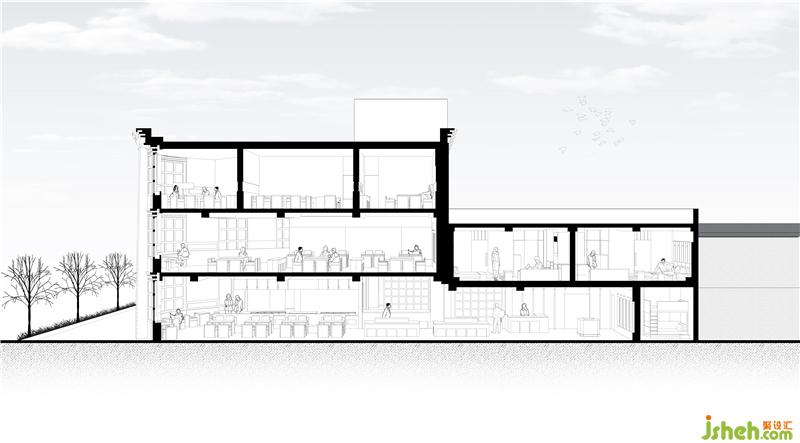
建筑剖面图©平介设计
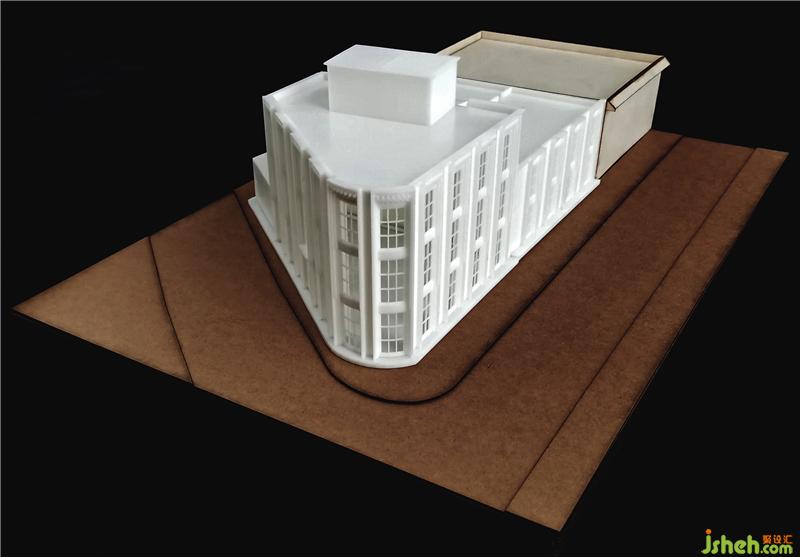
建筑模型©平介设计